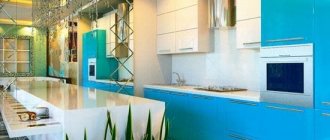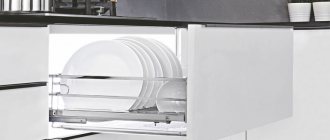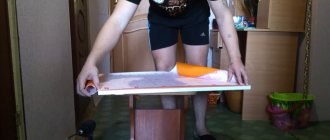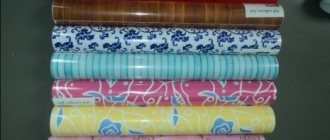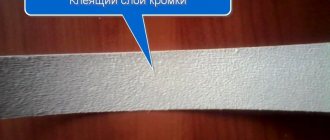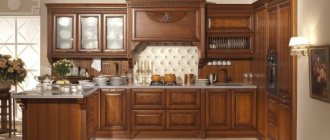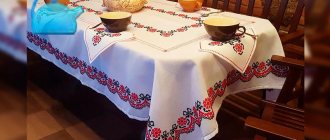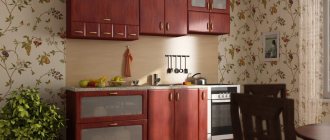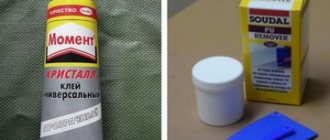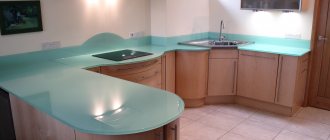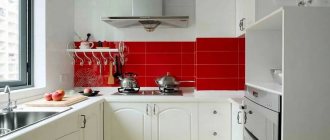The film on the facade of the MDF kitchen has peeled off: what to do, how to glue it
Hi all! Modern MDF kitchens are deservedly popular. This is the optimal balance between cost and quality. But it happens that the film on the facade of the MDF kitchen peels off, and it no longer looks the same as before.
This problem cannot be ignored under any circumstances, since the film plays not only a decorative, but also a protective function. With prolonged peeling, steam, fats, and temperatures will affect the MDF itself, which will have a detrimental effect on its condition and service life.
You can figure out how to put the peeled film back on yourself. Such repairs should not cause much difficulty. Please note that we will talk specifically about how gluing is performed, and not a complete replacement of the furniture façade film. Restoring film on facades with milling will be somewhat more difficult. This is due to the complex shapes of the product.
What to do if the film comes off?
It will take time to reupholster kitchen MDF facades. And I don’t really want the film to come off after a month or two and the film on the headset or cabinet to peel off. If you follow the gluing technology and operating rules, this should not happen.
But if in some places the film moves away from the base, it can be glued. You will need a syringe and glue (for example, “Moment” or “Titan”). It is inserted under the film and pressed into the restoration site.
With the help of adhesive-based films, you can give a new breath to MDF kitchen facades and kitchen units made of any material. An ordinary, neatly papered cabinet and set looks quite aesthetically pleasing. Follow the instructions and enjoy the results of your work.
Why is this happening
Let's start by examining the reasons why the film on your MDF kitchen facade has peeled off.
This can happen for several main reasons. Next, you will learn what to do in this situation, how to glue it and how to protect the film from the oven and other provoking factors.
In reality there are quite a lot of reasons.
But even on high-quality surfaces, peeling is possible.
This mainly occurs due to the oven and on the facades adjacent to it.
What happens is this: The housewife is preparing some dish in the oven, which is heated to high temperatures. When you take out the dish, all the heat comes out and hits the façade. As a result, the glue melts, loses adhesion to the film, and it peels off.
There is a high probability of peeling off when exposed to sunlight. Gradual heating occurs, the film burns out, the glue dries out or melts. That's it, the grip is lost, and the result is obvious.
To summarize, the following main reasons can be identified:
Sometimes there are several causes at once, or only one factor influences.
The result is the same. The film has peeled off and needs to be fixed.
Film, enamel or plastic - which is better?
Along with film finishing, enamel, acrylic or plastic coating is popular. At first glance, it is difficult for an uninformed buyer to determine the material used for the manufacture of furniture facades. How is film different from plastic and enamel? Which is better to choose? To answer these questions, you need to know the main features of these materials.
Plastic MDF facades. Plastic coverings of facades have a bright glossy surface. Such facades are resistant to mechanical damage, do not deform from exposure to moisture or high temperature, and do not fade in the sun. The colors are varied, but the palette is not as wide as that of film. Plastic facades are perfect for kitchens, bathrooms or hallways. The disadvantages include the higher cost compared to film facades, as well as the fact that handprints are clearly visible on the plastic. Restoration, as in the case of film, is impossible.
Acrylic facades. Coating furniture facades with acrylic is a new technology for us. This process is quite complicated, so furniture with acrylic fronts cannot be called cheap. Acrylic has an even smoother and glossier surface than plastic. This can be considered both an advantage and a disadvantage: the excessive shine of furniture, although beautiful, can be very tiring, and fingerprints will also have to be removed. Acrylic is environmentally friendly and does not contain harmful impurities. It is much more resistant to mechanical damage than plastic or film. Bright, rich color does not fade over time and does not fade in the sun. But acrylic facades cannot boast of a variety of shapes: they are only dull and even. If you need furniture of more complex shapes, you will have to make a choice in favor of film or painted facades.
MDF facades covered with enamel. Painted facades (enamel) can cause confusion among uninformed buyers: they are just painted, why are they so expensive? The fact is that coating MDF with enamel is a technologically complex, multi-stage process. First, the surface of the slab is primed, then enamel is applied in several layers, thoroughly drying each of them. After this, the paint layer is sanded, varnished and polished. The result is an environmentally friendly product that is resistant to light and minor mechanical damage. The main advantages of enamel facades are the ability to restore a scratched surface (and this is a big plus compared to film!), a huge variety of color palettes (more than 700 colors!) and special effects (metallic, chameleon, mother-of-pearl, galaxy, pearl, etc.). There are four main textures: high gloss, gloss, matte, abrasive surfaces. Disadvantages include the high price and, again, hand marks.
Film, plastic or painting: which is better? Which furniture to choose depends on the buyer’s priorities. If you need special strength, brightness and durability and there is no need to strictly save money when ordering, plastic or acrylic will do. Enamel facades are chosen by those for whom price is not important, but require, for example, unusual colors or special resistance to sunlight
If you have a small budget, you should pay attention to high-quality, fairly durable and easy-to-care furniture with film fronts. The difference in price between enamel and film can be quite significant, amounting to tens of thousands of rubles, if, for example, furniture for a large kitchen is ordered
Ways to solve the problem
The popularity and advantages of MDF facades are undeniable, but incidents also happen with them.
This is mainly due to the fact that operating rules or production technology have been violated. And sometimes two reasons at once.
Let me separately and as briefly as possible try to talk about restoration methods.
Friction recovery
This may seem strange to some, but the method really works.
It is best to use this technique in the early stages, when the film has only recently peeled off.
The meaning of the procedure is to perform the following sequential actions:
Just don't rub too quickly or vigorously. Take short breaks, don't put too much effort. Otherwise, the film may be damaged.
Heating with a hair dryer
An alternative would be another method of heating the film, but using an appropriate device.
A regular hair dryer may work, but it is better to use a construction hair dryer.
In this case, the sequence of operations is as follows:
The method will help if the glue has really dried out and lost its properties. Having melted it, it is often possible to restore it without using a new layer of glue.
Restoration with glue
Often home craftsmen first start with this method. But here everyone decides for himself.
To work, you will need quick-drying glue. Choose any one at your discretion.
The composition must be applied to the inner surface of the film and to the MDF facade itself. Then press and gently rub.
How to update furniture with film?
The replacement technology is very simple: in fact, you just need to remove the film from the paper and apply it to the facade or body of a floor or wall cabinet. In fact, there are also some nuances here that should be taken into account.
Most often, vinyl film is used to update kitchen cabinets, since it is not only resistant to moisture, but also does not fade in the sun, and this is important for the kitchen. It is very easy to work with it; it is possible to replace the appearance of facades made of chipboard, MDF, wood and even plastic panels
It should be taken into account that the self-adhesive film will mask stains or abrasions on the facade, but it cannot hide unevenness or deep scratches.
When finishing MDF facades with trimming, that is, gluing the end, it is necessary to use a heat gun. When cutting, take into account the tolerance on the ends and cut the workpiece at the corners. First, the material is laid on the surface and then glued to the ends.
The following videos demonstrate updating an MDF kitchen unit using decorative film.
Useful tips
Quite often, household members forget one simple truth.
MDF film does not like elevated temperatures, and therefore you need to try to insulate the material from strong heat. Otherwise, peeling will occur constantly.
Therefore, here I can highlight several practical recommendations:
Have you ever encountered films that peel off? How did you resolve this issue? What restoration methods were used?
Subscribe, leave comments, tell us about your situations and don’t forget to come to us again!
Source
Restoration of glossy coatings
Another way to restore the kitchen facade with your own hands is varnishing. This method allows you to show the beauty of the texture of different species, gives the furniture an expensive and representative look.
In order for the surface to sparkle with gloss, it is pre-prepared. All fittings are removed, after which the paint from the facade or old varnish is removed. The wood is cleaned with emery, first coarse-grained, then fine.
Existing cracks in kitchen facades are sealed with putty, which is matched to the color of the wood. To make it look more similar, sometimes colored pigments are added to it. The putty must be dried before you begin varnishing the facade.
If necessary, use a special transparent primer. She:
- levels the surface;
- creates a protective layer;
- enhances the texture of the source material.
The peculiarity of working with varnishes is that it is applied in several layers. The first layer is made as a base layer, allowed to dry, after which the next one is applied. The last layer is made the thinnest and most transparent. It gives the facade a glossy shine and enhances the depth of the pattern.
The varnish should be allowed to dry before hanging the doors in place. Drying it with a hairdryer is not recommended. Characteristic ripples may appear. It will ruin the appearance.
MDF in PVC film: how they glue it in factories and how to do it yourself - Review + Video
MDF in PVC film: how they glue it in factories and how to do it yourself. Often you want to give furniture a second life, or just change something in your apartment and do it inexpensively. Let’s not talk about what is better – film or painted MDF, but let’s immediately note that facades covered with film are the future. The fact is that such components are much more durable and neater looking, and, importantly, much cheaper to produce than painted or enameled MDF. Modern furniture with a bright glossy polymer coating is very beautiful.
When choosing a film for MDF kitchen facades, you should remember that even high-quality enamel will begin to peel off or swell after a while, so the service life of the film coating can last several decades without the need for repairs.
Pasting furniture with self-adhesive film
Pasting furniture with your own hands takes a lot of time. You need to be patient and try to carefully complete each step.
Surface and material preparation
To properly prepare the surface and the product for pasting furniture, perform the following steps:
Gluing technology
If a small area is to be treated, for example, the facade of a kitchen unit, the film can be applied using a dry method. When decorating a cabinet or other large object, the surface is first moistened with soapy water or soap. This provides the material with mobility and eliminates unevenness. This method is suitable for people performing such work for the first time. Pasting a cabinet with self-adhesive film is done as follows:
Difficult areas
Difficulties may arise when processing corners and other difficult areas. The following tricks will help you properly cover your cabinet with self-adhesive film:
Self-adhesive for furniture - what is better to buy
The second solution is to purchase a high-quality film that will have a high level of adhesion to all surfaces, even wood.
Similar materials can be bought in such large construction stores as Leroy Merlin, and the cost will vary from 130 to 900 rubles per roll.
The standard length of a really high-quality coating, having a thickness of 0.3 to 0.5 mm, in a roll will be 2 meters with a width of 0.45 meters. The difference in cost is determined by the thickness of the material you choose and the quality of the adhesive composition. It turns out that the higher the cost of the film, the better it is.
DIY kitchen furniture repair
If something in old furniture is broken or it has lost its appearance, this does not mean that it is necessary to change it. Furniture can be restored, any furniture, including kitchen furniture. To begin with, it is important to determine what exactly is broken, whether it is possible to fix it, whether the repair will be temporary or whether the furniture can still last for a long time.
If the set is made of good quality material or only the correction of cosmetic defects is required, repairing kitchen furniture with your own hands is justified. This is especially true for wooden furniture; it can be repaired several times.
But more affordable furniture made from MDF and chipboard can also be repaired when, for example, you need to improve the appearance of the facades.
Cosmetic repair of kitchen furniture
Usually, the kitchen loses its appearance the fastest, and this is most noticeable on the facades. If these are MDF facades, then in some places the film comes off (the ends of the facades are vulnerable spots), scratches appear, stains from various contaminants, such as grease, appear, the coating changes color and becomes uneven in tone.
Restoration of minor damage
Minor damage includes chips, scratches, and abrasions.
- Chips are removed using wax. The chip, pre-aligned along the edges, is filled with molten wax, sanded, and then painted over with special felt-tip pens, selecting colors. Then they are secured with a finishing layer of varnish.
- Scuffs are rubbed with a soft microfiber cloth, onto which dye from a felt-tip pen has been applied.
- Scratches are polished with furniture wax.
- If any parts come apart, coat the edges with PVA glue and press them together with clamps.
- The edge is cut into pieces according to the dimensions of the tabletop, with small allowances. First, blanks are made for the long sides, then for the short ones.
- Then the iron is adjusted so that the edge does not overheat and swell.
- The edge is applied evenly to the end. For convenience, you can place the tabletop with the end up.
- An iron is moved along the edge with uniform, leisurely movements, as a result of which the glue melts and the edge is glued to the end.
- While the glue has not cooled, you need to press the edge to the tabletop, ironing it with pressure along the edge with a piece of felt or a rag.
- The excess edge at the corners is trimmed with scissors and trimmed with a knife.
- The excess edge at the top and bottom, if it does not fit in width, is cut off with a knife, gradually, towards the tabletop. And then they go through it again in one motion, placing the blade at an angle of about 45 degrees to the tabletop.
- Corner joints are lightly sanded with fine sandpaper.
Minor defects can be painted over
It happens that the edge of a tabletop set or kitchen table comes off. It can be replaced with a new one that matches the color. To do this you will need the edge itself, scissors, a construction knife, and an iron.
The film is swollen and peeling off
The peel-off film can be glued back if this drawback is minor. Regular PVA glue is suitable for these purposes. The main thing is to get to all hard-to-reach places.
: gluing shrink film with PVA glue
When the problem becomes global, the film will have to be removed. This is done as follows.
First you need to remove the fittings. You can also remove the facades themselves, which will make working much more convenient.
How industrial cladding of furniture facades is done
Next, we suggest you familiarize yourself with how components for headsets are made. The industrial production of MDF facades and their subsequent decoration using film is carried out in this way.
Much of the production process is automated, and for this reason the resulting products are neat, high quality and relatively inexpensive. So, now you know what stages parts go through when covering with vinyl film. Unfortunately, all these steps of the production process cannot, for obvious reasons, be implemented at home for beautiful and neat pasting. However, there is another option that makes it possible to restore or update furniture using PVC film.
Using self-adhesive film is a great way to update your kitchen set
A good quality kitchen set can last for decades. But time passes, and the shine of the new furniture fades, stains, chips and scratches appear, and your favorite set or any of its cabinets are no longer pleasing.
There are two ways out of this situation: do some repairs and buy new furniture, or update existing cabinets and pencil cases. Moreover, in the second case, the cost of the issue will be minimal, and you will not have to deal with rearrangements. All you need is decorative self-adhesive film.
Pasting furniture facades at home
And now we propose to consider how to glue MFD film to a facade that has a flat surface.
To complete all the work that is planned, you will need the following tools and devices:
Please note that you should really only use a new spatula, since a used tool will still have irregularities that are almost invisible, and they will scratch the films during smoothing.
The upcoming work consists of the following stages:
Gluing PVC film to the furniture facade => preparing the surface for processing => cutting PVC film => gluing the material to the furniture => trimming excess film => final leveling of the finished surface.
Instructions for gluing the PVC coating yourself are attached below. Despite the fact that the described steps for gluing film on MDF are simple in themselves, the quality of the final result will largely depend on how accurately you follow it.
If you follow all the instructions correctly, the result will be almost the same as on factory-made furniture facades.
Please note that a feature of adhesive-based PVC films is the small thickness of the material. As a result, even small specks of dust or irregularities on the surface being pasted will be visible to the naked eye. For this reason, you should wipe the facade with a damp cloth and check for dust under a bright flashlight or lamp before starting work.
Pasting tabletops with wood-look film
Advantages and disadvantages of the material
The film looks great on walls, doors, countertops and other interior items
To make sure that the decision to cover a worn door leaf with film is justified, you should consider in more detail the characteristics of the finishing element. At its core, self-adhesive is a polymer material. In most cases, it is a PVC film, on which a binding mass is applied on one side, and decorative design on the other. Thus, due to the unnecessary application of an additional layer of glue to the product, installation of the finishing material is carried out very quickly, accurately and without much effort. In addition to ease of installation, self-adhesive films have the following positive qualities:
However, such films have disadvantages, albeit insignificant:
Furniture manufacturing. How to glue film on MDF facade?
December 7, 2022
Covering MDF furniture with films made of polyvinyl chloride (PVC) or other polymers is an effective and inexpensive way to decorate it and protect it from external factors. Using this method, you can obtain facades of various colors and textures, protect them from ultraviolet rays, heat, moisture, the influence of cleaning agents, etc.
The film can be glued both to flat surfaces (for example, on a door) and to textured ones. Also, the advantage of film facades is their ease of maintenance - they just need to be wiped with soapy water.
What is the material
With the help of self-adhesive film it is possible to update any design. It is not difficult to stick it on different substrates, and the resulting coating has a long service life and is highly attractive.
Film for pasting furniture consists of several layers:
Self-adhesive films are produced using different technologies. For each method, specialized equipment is used. The following methods are used for this:
Thus, updating various interior items with a special self-adhesive film for furniture is an excellent solution for every owner of these structures. Self-adhesive film for furniture has many unique parameters, is suitable for gluing various surfaces, and is also intended to protect them from various negative influences.
What glue should I use to glue the film to MDF?
Adhesive for PVC film must meet a number of criteria - provide sufficient wetting of the surface, the possibility of activation after application, not form “threads” and have good viscosity. Therefore, furniture production experts recommend turning your attention to adhesives from the German company Henkel. Its adhesives are characterized by a number of advantages:
do not contain solvents;
do not dirty the equipment during processing of workpieces;
can successfully glue MDF and films made of PVC, PET, ABS and other polymers;
high initial strength of the seam;
resistance to temperature changes and steam, making them ideal for use on kitchen furniture facades;
Depending on your process setup, you can choose one-component (ready-to-use) or two-component (requires mixing with a hardener) adhesives. Regardless of the type, all Henkel adhesives have excellent German quality combined with a very reasonable price.
Types of self-adhesive films
Self-adhesive films can have different colors, textures and embossing
As a rule, products are produced in rolls, the width of which is 45, 67.5 or 90 centimeters. The length of the skein can also be different - 2, 8, 10 or 15 meters. As noted earlier, the range of products is very wide. There are both inexpensive solid-color models and products with various textures and patterns on sale. The industry even offers designer stickers from famous designers, but the cost of such products is quite high. In general, the following types of PVC films are used for finishing doors:
Helpful advice: Choose a film depending on the object of its installation and personal preferences
At the same time, you should not focus on the most budget models from little-known manufacturers, since their quality usually leaves much to be desired.
Benefits of façade renovation
Self-adhesive film was used to restore the facades. There are times when it begins to come off: if the MDF film has peeled off in the kitchen, you should not rush to replace it with a new one. The film often peels off due to humidity, temperature changes, steam, and the use of low-quality glue.
You should not be surprised if peeling occurs quite quickly, even during loading after manufacture or when the product has a short lifespan. The film peels off from MDF facades for the following reasons:
Difficulties in work and their solutions
Problems often arise with processing the ends and shaped parts of kitchen units made of MDF or other material. An industrial or household hair dryer will be a good helper in this case.
The restoration will go faster if you work together: one person stretches the material by heating it with a hairdryer, the other carefully glues it to the base.
It is easier to apply the self-adhesive tape evenly on a damp surface. To do this, lightly moisten cabinets and doors with a spray bottle. Water will not allow the material to immediately grasp the surface and will provide an opportunity to correct the work.
When cutting the material, you need to make allowances on each side. For parts with ends, do not forget to make cuts in the corners. First, they paste over the part itself, and then proceed to the ends. The rounded ends of MDF facades are treated with a hairdryer for a better fit.
How to fix the problem?
If the film on the facade of the MDF kitchen has peeled off , you need to carefully spread it with glue from the edge and press it down. There is a chance that the film will take the desired shape. Another way to restore the coating is to use an adhesive membrane. To do this, you will need to lay the boards on a dry and flat surface, for example, on a table, cover them with a membrane, and use a vacuum. The membrane should tightly cover the facades. If you want greater reliability, you need to use high-quality glue and heat the material so that it can be activated. Warming up should be done evenly. This method is suitable only for unmilled facades: if the surface is uneven, the membrane will not stick and will quickly peel off. Therefore, it is so important to correctly restore kitchen facades while observing certain conditions.
Technology of pasting furniture with polymer films
If you decide to update your kitchen furniture using self-adhesive film, then first prepare the base. It should be understood that the decorative covering will not hide potholes and bumps, it will only disguise the stains, so all unevenness must be removed before pasting. A video with tips will simplify the workflow.
12 rules for working with self-adhesive tape
- The fittings and doors must be removed, and each kitchen cabinet (facades and frame) must be inspected for the presence of depressions and bulges.
- If there are defects on the furniture, all irregularities are filled with putty and sanded well.
- To calculate material consumption, you will need measurements of all parts of the kitchen unit. You need to carefully measure all the parts that you plan to paste over.
- All dimensions are transferred to the back side of the film. It is usually made of white paper, on which the drawn lines are clearly visible.
- When cutting, you should always leave a margin of about 1 cm. This will help in your work: if you start gluing the vinyl at the wrong angle, the margin will make it possible to correct the situation. All excess is easily cut off with a breadboard knife.
- Decorative self-adhesive film is cut with a stationery knife, curved lines are cut out with scissors.
- Then you need to degrease all the surfaces to be decorated so that the “self-adhesive” does not come off over time. Window cleaning liquid or other products are suitable for this. Grease stains need to be treated especially carefully so that the decorative finish does not come off.
- Pasting of kitchen units is carried out on a dry and clean surface, otherwise the “self-adhesive” will begin to bubble and peel off from the base.
- The film must be applied evenly.
- The backing is removed in several stages: first, only a few centimeters are peeled off, after gluing them, a little more is removed, and so on until the entire panel covers the part to be decorated.
- Smooth out the plastic decor from the middle to the edges. Air bubbles must be removed during operation. It is convenient to work with a plastic scraper, stroking the surface with a soft cloth.
- Small air inclusions are removed with a needle. The finished part can be processed through the fabric with a warm iron.
Using heating devices
If the PVC film peels off from MDF kitchen facades, you can try replacing it with a new film or gluing the old material in place using available electrical appliances. This could be an iron, a powerful home or construction hair dryer. The film needs to be carefully warmed up: it should become quite soft and blurry, but not start to melt. If you have something to try, use these pieces or on an inconspicuous place on the façade. The device is pressed against the edge that is not glued for a few seconds. The film should stretch, the glue should warm up at this moment, and the material should protrude towards the back side of the facade and adhere firmly. If this can be done, then it will be possible to glue the entire facade in this way, in places where the film has retreated.
Advice: the film itself cannot be heated with a hairdryer at close range, as this will curl it and be damaged.
This DIY restoration of kitchen facades requires some skill, but is quite simple to perform and does not require the use of expensive tools or materials. If the inside and corners are poorly glued, you can use a metal rod comparable in size to the frame. First you need to warm it up. For this, you can use, for example, a gas burner.
Restoring coating using friction
Restoring kitchen facades from MDF using this method does not require any available tools at all. In order to glue the separated section of the film, you need to cover it with a rag and start rubbing it with your fingers, pressing the film. If there is adhesive underneath, the temperature from friction in a small area will be enough to activate a chemical reaction and cause the film to stick.
Advice: this method should be used carefully, as there is a high risk of damaging the film, exposing its edge or removing the top layer, which will ruin the appearance of the coating.
Application of glue
Restoring a glossy kitchen can cause some difficulties, since gloss does not tolerate strong physical impact, which is why it should not be roughly rubbed with your fingers or heated closely with any appliances. You can try a safer method - gluing the separated film using “Moment”. Most often, such a film peels off in the kitchen, since it is not affected by hot steam. It is necessary to restore the coating as quickly as possible, otherwise the furniture itself will be damaged. The glue must be applied to the untreated area of the facade and to the film itself along the edge so that it can isolate the seam from negative influences. All this must be done carefully, as the glue easily sticks and gets dirty.
Conclusion: inexpensive do-it-yourself kitchen restoration is quite accessible; it is advisable to look at photos of the finished results in advance. With a careful and competent approach, you can easily restore the appearance of the kitchen without resorting to replacing parts and without spending money and completely replace the facades.
Source
Features of operation
Think about it, PVC film sticks at a temperature of 120 - 180 degrees, and if your oven produces at least 60 -100 degrees outside, this already poses a threat to the cabinets located nearby.
Install the thermal insulation strip. It protects the ends of the cabinet from heating by the stove and avoids delamination of the edges. It is installed at the ends of the cabinet. It is very easy to care for: to remove dirt, it is recommended to wipe with a damp cloth, but it is not recommended to use any cleaning agents.
- Avoid high humidity. If you are still in doubt whether to install a hood or not, then I think your choice is now obvious. Steam from pots and grease from frying pans will also not have the best effect on your furniture.
- Water is the enemy of any furniture. Make sure that it does not get on the facades.
- Close doors and slide drawers carefully, avoiding sudden movements. Do not expose them to mechanical stress (contact with sharp objects, friction, impact).
- The close location of lighting fixtures can lead to excessive heating of the facade and, as a result, deformation of the film, as well as a change in the color of the facing coating. The lamp and the facade should not be closer to each other than 15 cm.
How to do the work yourself
To carry out the procedure on your own, you will need a small number of tools and auxiliary materials; a specific list is selected from the selected technology for carrying out the work:
- vinyl film;
- measuring tape and ruler;
- cutting tools;
- roller or soft cloth;
- accessories.
For a more comfortable and accurate process, the components must be removed and placed in a horizontal position. You should remove and unscrew all removable fittings that interfere with the quality of the sticker.
By preliminary preparation, the surface to be prepared is degreased and smoothed from roughness. It is necessary to dry from degreasing within 24 hours.
Having carefully measured and cut the vinyl film, you can begin gluing the MDF surface. For each facade, it is necessary to cut the film with a small margin of size on each side. You need to take a reserve of about 2 centimeters.
The film should be applied without haste, very carefully to avoid the formation of bubbles and damage to the material. It is best to iron the film with a special roller, or a sponge or soft cloth.
After the film is applied to the surface, old or newly purchased fittings are screwed into their original places. When all the components of the furniture are ready, you can begin assembly.
Important nuances and tips
It is important not only to buy a good adhesive, but also to use it correctly and know the rules of use:
- You always first read the instructions and determine which surfaces you can work on.
- The composition should not contain toxins; if they are present, appropriate actions should be taken (protection, ventilation).
- Surface preparation, thorough cleaning.
- A large mass of products are produced in white or yellow, but if the design is colored, then you need to choose a colorless material.
- A thick layer does not provide better adhesion, the main thing is that it is uniform.
- It is necessary to fix the connection until it dries completely.
Repair of wooden surfaces
Monolithic elements of furniture sets made from solid natural wood are restored by re-painting the facades.
For the kitchen it is better to choose enamel rather than paint. The first has a higher degree of abrasion resistance and fades less.
Acrylic enamels are water-based. Having chosen to paint kitchen wooden facades with this material, it is recommended to apply a protective layer of transparent varnish on top. Alkyd enamels do not need such protection.
Painting kitchen facades is a popular method because it does not require much expense and takes little time. Most often, a different color is simply applied on top of the old, washed and degreased layer.
In case of major damage (deep scratches, holes, traces of fire), it is necessary to prepare the natural wood surface. Old paint is removed using chemicals (removers) or heating with a hairdryer. After this, the wood is cleaned with fine emery cloth. Deep damage must be filled with a special putty for wood. To ensure that the composition holds better, cracks and crevices are cleaned of dust and debris.
The putty is applied using a plastic spatula, pressing it in so that it fills the entire space. Otherwise, it will sag and depressions will appear.
The next step in restoring the coating is applying a primer. It will create better adhesion of the base to the paint, play the role of a protective layer, and extend the service life of the product.
The last stage is coloring. It is done with a paint roller or brushes of different widths. Narrow ones are used to process thin relief parts (they are painted first), wide ones are used for panels and other planes. For best results, it is recommended to apply several layers of paint.
The best PVA-based adhesives
PVA glue for wood is in demand in office supplies, as well as when working with wood. Such an environmentally friendly product will not leave marks, has a strong adhesion, but does not withstand moisture well. When comparing 8 products, it was determined which one is better. The list contains 4 of them.
Kiilto PVA D3
The product is known for its white color and thick composition. The best glue for wood, as it has moisture-repellent properties, is able to withstand 5 freezing cycles down to -40 degrees, maintaining all the basic qualities. Currently produced by a large number of developers, including the Finnish brand - Kiilto.
Advantages:
- Safe, based on water dispersion;
- Available in 1 and 3 liter packaging;
- Cost-effectiveness;
- Fire resistance;
- Promotes sound insulation;
- Thermal resistance.
Flaws:
- You need a brush or roller to use;
- Applicable only at +10 degrees.
Based on reviews, the product will create a reliable connection and has a wide temperature range. In view of this, all materials that are of wooden origin are glued together.
Moment Super PVA D3 moisture resistant
The Russian wood glue Moment Super PVA D3 is moisture resistant and has good operating characteristics. It is used to glue various objects made of wood, veneer and materials containing wood inclusions. The product is slightly inferior to the leaders in the duration of setting (15-20 minutes) and complete drying (days).
PVA glue for wood will not leave marks on the material after drying. The water dispersion will retain its qualities at temperature parameters from +5 to +30 degrees. This characteristic feature is indicated by buyers in responses as a minus of the product. Consumers note the reliability, transparency, and availability of the adhesive composition in question.
Advantages:
- Transparency;
- Withstand static load;
- Versatility;
- High water resistance;
- There is no unpleasant aroma.
Flaws:
- Cannot cope with dynamic load;
- Properties decrease at sub-zero temperatures.
Moment Super PVA D3 moisture resistant differs from analogues in a longer compression time (20 minutes). Complete drying will occur after 24 hours.
PVA professional Tex Universal
Various materials can be glued together using TEX PVA Joinery Professional. Among them are wood, cardboard, paper products, leather, linoleum. Bonding strength is achieved due to excellent adhesion. At the same time, the seam is characterized by increased reliability and elasticity.
The composition is white, which should not alarm the consumer. After drying, it will become transparent, so it will not spoil the formed knot. Experts note the comfort during work and the absence of unpleasant odors. The adhesive composition deservedly occupies a leading position in the ranking. Experts note the strength of adhesion. The downside is the high consumption of glue; it dries after 1 day.
Advantages:
- Versatility of use;
- Non-toxic materials;
- There is no unpleasant aroma;
- Comfortable packaging;
- Proper strength.
Flaws:
Uneconomical use of material.
Based on reviews, PVA Tex is a universal wood glue. It is produced in a comfortable package that is easy to use. Equipped with an ergonomic lid, the gluing process is fast and reliable.
PVA Lakra Builder universal
High quality product based on PVA water dispersion. PVA Lakra Builder universal is characterized by increased setting reliability and quick drying. Upon completion of setting, a flexible transparent film is formed. The composition is recommended by experts for carpentry: gluing wooden objects, furniture, gluing linoleum (made of fabric), leather goods, cardboard, paper.
Advantages:
- Excellent adhesion to paper and wood;
- Materials are non-toxic;
- Just wash;
- No aroma;
- Economical spending.
Flaws:
Flammability of materials.
Based on reviews, the adhesive is distinguished by a thick, homogeneous composition without lumps or foreign impurities.
Unlimited possibilities of self-adhesive film
Kitchens covered with film look impressive both in photos and in real life. Surfaces are updated using vinyl or other film. The range of this material is amazing in its diversity, and the price pleases with its affordable price.
Decorative “self-adhesive” imitates:
- natural wood of different species;
- natural stone;
- ceramics and tile texture;
- leather and fabric.
In the photo - imitation wood
In its texture, it can resemble patterned silk, a colorful tapestry or cute chintz. The material is produced in matte and glossy versions. There are films with holographic and mirror patterns. And all this can be combined with each other, creating interesting effects, changing an ordinary kitchen cabinet beyond recognition, as in the photo below.
The price of the film depends on the manufacturer and the decorative surface.
Vinyl “self-adhesive” is quite practical because it:
- not afraid of moisture;
- does not fade in the sun;
- does not respond to temperature changes.
With its help, you can completely update the design of both the kitchen and the bathroom, transform the kitchen cabinet or the entire set.
Adhesive film is a good budget replacement for a full-fledged repair. Of course, you need certain knowledge and skills, but the video will help you quickly understand the intricacies of the process.
Choosing a loft bed with a work area and wardrobe design options
There are several ways to solve the problem. For starters, this is a complete replacement of facades that are no longer suitable for restoration. If you just want to put the film back in place, there are several solutions you can use. For starters, this is the temperature effect. By heating the glue, it returns its characteristics, begins to cling to the surface, and thereby the facade is restored. An alternative is to use glue. Moreover, the experts advise first to try the first method, and then switch to glue.
Let me separately and as briefly as possible try to talk about restoration methods.
Friction recovery
This may seem strange to some, but the method really works.
It is best to use this technique in the early stages, when the film has only recently peeled off.
The meaning of the procedure is to perform the following sequential actions:
- it is advisable to remove the problematic door or facade;
- prepare a clean, dry cloth;
- place the facade on a flat horizontal surface;
- apply a rag to the problem area;
- start moving the rag with slight pressure back and forth;
- try to wipe away the peeled off area;
- the temperature due to friction will gradually increase;
- the dried glue will warm up;
- its adhesion properties will return;
- the film will return to its place.
see also
Comments 23
I use Abet laminati plastic and Wilsonart 800 or 801 glue. I apply the glue with a spray gun in 2 layers. According to the instructions for this glue (found in the public domain), the main thing is the pressing force of the parts being glued, and not the time. The first layer dries in about 10 minutes, the second becomes dry in 10 minutes or even less, but continues to set for some time,
10 minutes - plastic glued during this period of time, then even with a knife it is cut off with great difficulty. According to the instructions for the glue, the plastic can be milled immediately after gluing the parts and immediately proceed to the next stage of processing the part. The final processing is done with an angular cutter 15 - 25 ° and sandpaper 100
where can I get this kind of plastic?
2 points: as my friend says, “the sandpaper is in your pants, but this is sandpaper” - but these are minor things. The second point is that the glue does not need to be cured after gluing; the compression force is more important than time. If you tap the glue with a mallet, then this is quite enough, and by the sound it will be clear where it is glued and where you still need to knock.
